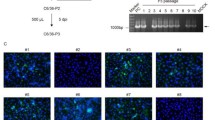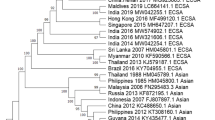Abstract
After the 2005-2009 chikungunya epidemic, intermittent outbreaks were reported in many parts of India. The outbreaks were caused by either locally circulating strains or imported viruses. Virus transmission routes can be traced by complete genome sequencing studies. We investigated two outbreaks in 2014 and 2019 in Kerala, India. Chikungunya virus (CHIKV) was isolated from the samples, and whole genomes were sequenced for a 2014 isolate and a 2019 isolate. Phylogenetic analysis revealed that the isolates formed a separate group with a 2019 isolate from Pune, Maharashtra, and belonged to the East/Central/South African (ECSA) genotype, Indian subcontinent sublineage of the Indian Ocean Lineage (IOL). A novel mutation at amino acid position 76 of the E2 gene was observed in the group. The phylogenetic results suggest that the outbreaks might have been caused by a virus that had been circulating in India since 2014. A detailed study is needed to investigate the evolution of CHIKV in India.

Similar content being viewed by others
References
Galán-Huerta KA, Rivas-Estilla AM, Fernández-Salas I, Farfan-Ale JA, Ramos-Jiménez J (2015) Chikungunya virus: a general overview. Med Univ 17(68):175–183
Volk SM, Chen R, Tsetsarkin KA, Adams AP, Garcia TI, Sall AA et al (2010) Genome-scale phylogenetic analyses of chikungunya virus reveal independent emergences of recent epidemics and various evolutionary rates. J Virol 84(13):6497–6504
Mascarenhas M, Garasia S, Berthiaume P, Corrin T, Greig J, Ng V et al (2018) A scoping review of published literature on chikungunya virus. PLoS ONE 13(11):e0207554
Lahariya C, Pradhan SK (2006) Emergence of chikungunya virus in Indian subcontinent after 32 years: a review. J Vect Born Dis 43:151–156
Kalantri SP, Joshi R, Riley LW (2006) Chikungunya epidemic: An Indian perspective. Natl Med J INDIA 19(6):9
Diop D, Meseznikov G, Sanicas M (2015) Chikungunya outbreaks from 2000 to 2015: a review. MOJ Public Health 2(6):181–187
Pyke AT, Moore PR, McMahon J (2018) New insights into chikungunya virus emergence and spread from Southeast Asia. Emerg Microbes Infect 7(1):1–3
Newase P, More A, Patil J, Patil P, Jadhav S, Alagarasu K et al (2020) Chikungunya phylogeography reveals persistent global transmissions of the Indian Ocean Lineage from India in associationwith mutational fitness. Infect Genet Evol 82:104289
Domingo E, Holland JJ (1997) RNA virus mutations and fitness for survival. Annu Rev Microbiol 51(1):151–178
Carletti F, Bordi L, Chiappini R, Ippolito G, Sciarrone MR, Capobianchi MR, Di Caro A, Castilletti C (2007) Rapid detection and quantification of Chikungunya virus by a one-step reverse transcription polymerase chain reaction real-time assay. Am J Trop Med Hyg 77(3):521–524
Stapleford KA, Moratorio G, Henningsson R, Chen R, Matheus S, Enfissi A et al (2016) Whole-genome sequencing analysis from the chikungunya virus caribbean outbreak reveals novel evolutionary genomic elements. PLOS Negl Trop Dis 10(1):e0004402
Kumar S, Stecher G, Tamura K (2016) MEGA7: molecular evolutionary genetics analysis version 7.0 for bigger datasets. Mol Biol Evol 33(7):1870–1874
Bordi L, Carletti F, Lalle E, Colavita F, Meschi S, Di Caro A et al (2018) Molecular characterization of autochthonous chikungunya cluster in Latium region, Italy. Emerg Infect Dis 24(1):178–180
Niyas KP, Abraham R, Unnikrishnan R, Mathew T, Nair S, Manakkadan A et al (2010) Molecular characterization of Chikungunya virus isolates from clinical samples and adult mosquitoes emerged from larvae from Kerala, South India. Virol J 7(1):189
Afreen N, Deeba F, Khan WH, Haider SH, Kazim SN, Ishrat R, et al (2014) Molecular characterization of dengue and chikungunya virus strains circulating in New Delhi, India: DENV and CHIKV strains from India. Microbiol Immunol l58(12):688–96
Wahid B, Ali A, Rafique S, Idrees M (2017) Global expansion of chikungunya virus: mapping the 64-year history. Int J Infect Dis 58:69–76
Chen R, Puri V, Fedorova N, Lin D, Hari KL, Jain R et al (2016) Comprehensive genome scale phylogenetic study provides new insights on the global expansion of chikungunya virus. J Virol 90(23):10600–10611
Acknowledgements
The authors acknowledge the Department of Health Research for financially supporting the study through extramural funding. We thank the Director of the National Institute of Virology and the NIV Kerala team, especially Mrs. Sreelekha, Kunjila K, and Miss Aiswarya Babu for all the support during the study. We also thank the institute manuscript review committee members, Drs. Bondre, Vaidya, Gurav, Alagarasu, and Sarah Cherian, for critical comments and suggestions. Our special gratitude goes to Thermo Fisher Scientific India Ltd. and the team for their sequencing work.
Author information
Authors and Affiliations
Corresponding author
Additional information
Handling Editor: Patricia Aguilar.
Publisher's Note
Springer Nature remains neutral with regard to jurisdictional claims in published maps and institutional affiliations.
Supplementary Information
Below is the link to the electronic supplementary material.
Rights and permissions
About this article
Cite this article
Anukumar, B., Asia Devi, T., Koshy, J. et al. Molecular characterization of chikungunya virus isolates from two localized outbreaks during 2014-2019 in Kerala, India. Arch Virol 166, 2895–2899 (2021). https://doi.org/10.1007/s00705-021-05186-9
Received:
Accepted:
Published:
Issue Date:
DOI: https://doi.org/10.1007/s00705-021-05186-9




